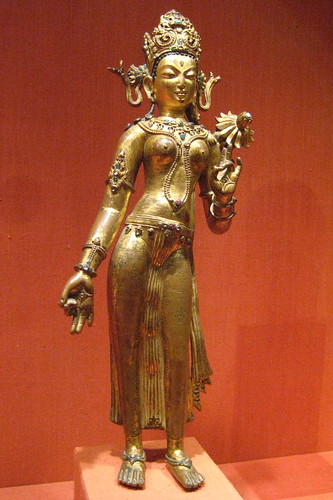NYC - Metropolitan Museum of Art - Standing Tara
Image by wallyg
Standing Tara
Nepal, 14th century
Gilt copper alloy with color, inlaid with semiprecious stones; H. 20 1/4 in. (51.4 cm)
Tara, the Buddhist savioress, is the most important goddess in the Buddhist pantheon. She stands in a hip-shot posture, with her right hand held in a boon-bestowing gesture (varadamudra) and her left raised in a teaching gesture (vitarkamudra). Her body is voluptuous. She is dressed in a long floral printed dhoti and a shawl is draped over her left shoulder, above which a lotus flower blooms. She is richly adorned in jewelry, including a crown, earrings, necklaces, armbands, wide cuffs, a belt, and anklets. The overall impact is one of elegance, refinement, and otherworldliness—an effect enhanced by the light reflecting off the smooth, sparsely adorned gilt-copper surfaces.
Nepali sculpture was greatly influenced by the sculpture of India. This sculpture's emphasis on flowing volume and elegant forms harks back to Pala examples. However, her wide face, large eyes, and pursed mouth are purely Nepalese, as are the elaborate foliate sworls in her crown.
Louis V. Bell Fund, 1966 (66.179)
**
The Metropolitan Museum of Art's permanent collection contains more than two million works of art from around the world. It opened its doors on February 20, 1872, housed in a building located at 681 Fifth Avenue in New York City. Under their guidance of John Taylor Johnston and George Palmer Putnam, the Met's holdings, initially consisting of a Roman stone sarcophagus and 174 mostly European paintings, quickly outgrew the available space. In 1873, occasioned by the Met's purchase of the Cesnola Collection of Cypriot antiquities, the museum decamped from Fifth Avenue and took up residence at the Douglas Mansion on West 14th Street. However, these new accommodations were temporary; after negotiations with the city of New York, the Met acquired land on the east side of Central Park, where it built its permanent home, a red-brick Gothic Revival stone "mausoleum" designed by American architects Calvert Vaux and Jacob Wrey Mold. As of 2006, the Met measures almost a quarter mile long and occupies more than two million square feet, more than 20 times the size of the original 1880 building.
In 2007, the Metropolitan Museum of Art was ranked #17 on the AIA 150 America's Favorite Architecture list.
The Metropolitan Museum of Art was designated a landmark by the New York City Landmarks Preservation Commission in 1967. The interior was designated in 1977.
National Historic Register #86003556
Standing Tara (Metropolitan Museum of Art)
Image by Ark in Time
Standing Tara
Nepal, 14th century
Gilt copper alloy with color, inlaid with semiprecious stones; H. 20 1/4 in. (51.4 cm)
Tara, the Buddhist savioress, is the most important goddess in the Buddhist pantheon. She stands in a hip-shot posture, with her right hand held in a boon-bestowing gesture (varadamudra) and her left raised in a teaching gesture (vitarkamudra). Her body is voluptuous. She is dressed in a long floral printed dhoti and a shawl is draped over her left shoulder, above which a lotus flower blooms. She is richly adorned in jewelry, including a crown, earrings, necklaces, armbands, wide cuffs, a belt, and anklets. The overall impact is one of elegance, refinement, and otherworldlinessan effect enhanced by the light reflecting off the smooth, sparsely adorned gilt-copper surfaces.
Nepali sculpture was greatly influenced by the sculpture of India. This sculpture's emphasis on flowing volume and elegant forms harks back to Pala examples. However, her wide face, large eyes, and pursed mouth are purely Nepalese, as are the elaborate foliate sworls in her crown.
Louis V. Bell Fund, 1966 (66.179)
**
The Metropolitan Museum of Art's permanent collection contains more than two million works of art from around the world. It opened its doors on February 20, 1872, housed in a building located at 681 Fifth Avenue in New York City. Under their guidance of John Taylor Johnston and George Palmer Putnam, the Met's holdings, initially consisting of a Roman stone sarcophagus and 174 mostly European paintings, quickly outgrew the available space. In 1873, occasioned by the Met's purchase of the Cesnola Collection of Cypriot antiquities, the museum decamped from Fifth Avenue and took up residence at the Douglas Mansion on West 14th Street. However, these new accommodations were temporary; after negotiations with the city of New York, the Met acquired land on the east side of Central Park, where it built its permanent home, a red-brick Gothic Revival stone "mausoleum" designed by American architects Calvert Vaux and Jacob Wrey Mold. As of 2006, the Met measures almost a quarter mile long and occupies more than two million square feet, more than 20 times the size of the original 1880 building.
In 2007, the Metropolitan Museum of Art was ranked #17 on the AIA 150 America's Favorite Architecture list.
The Metropolitan Museum of Art was designated a landmark by the New York City Landmarks Preservation Commission in 1967. The interior was designated in 1977.
National Historic Register #86003556
No comments:
Post a Comment